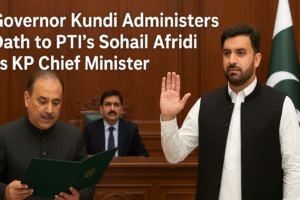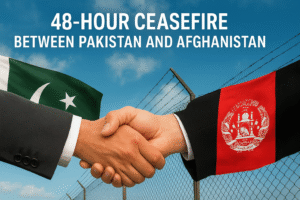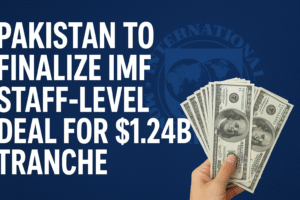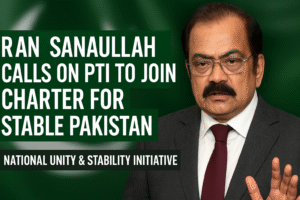Gaza Ceasefire Agreement Goes Into Effect: Egyptian Media
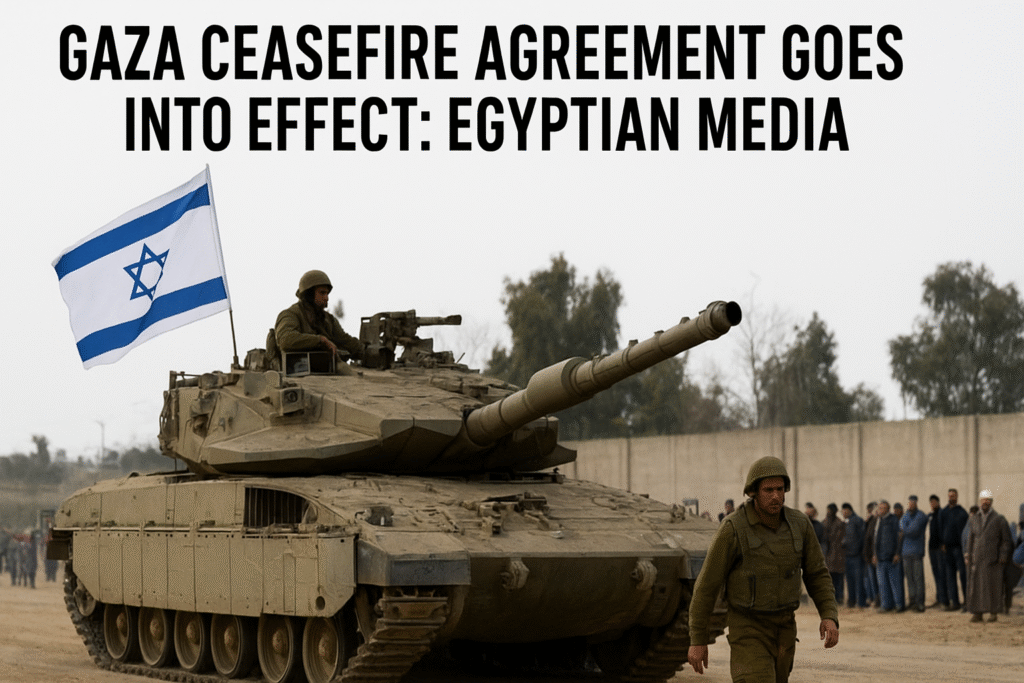
Introduction
Egyptian media has confirmed that a ceasefire agreement between Israel and Hamas has officially gone into effect, marking a potential turning point in one of the most devastating conflicts of the 21st century. According to Egyptian reports, the ceasefire began at 9:00 GMT, after a signing ceremony held in Sharm el-Sheikh.
This long-awaited truce, brokered through intense negotiations by Egypt, Qatar, Turkey, and the United States, offers hope for millions of Gazans who have suffered through relentless airstrikes, ground assaults, and humanitarian deprivation for nearly two years.
The development is being hailed as a diplomatic breakthrough — particularly for Egypt, whose leadership has played a critical role in mediating and securing the terms of this agreement.
But the question remains: will this ceasefire hold, or will it be another fragile truce in a long line of temporary pauses?
This comprehensive DawnWire analysis examines every dimension of the development — from the agreement’s details and humanitarian consequences to international reactions and what the deal means for the future of Middle East peace.Gaza ceasefire agreement, Egyptian media, Hamas Israel ceasefire, Gaza peace deal, Egypt.
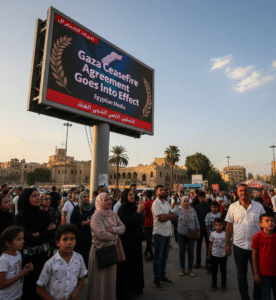
Background: The Long Shadow of the Gaza Conflict
To understand why this ceasefire matters, we must revisit the roots of the ongoing crisis in Gaza.
The conflict between Israel and Palestinian factions, especially Hamas, has persisted for decades. Each round of violence has left deeper scars and widened the gulf between peace and lasting stability.
In October 2023, the conflict escalated dramatically when Hamas launched a large-scale attack into southern Israel. The assault led to the deaths of over a thousand Israeli civilians and the capture of dozens of hostages. Israel’s military responded with overwhelming force, initiating a full-scale war on Gaza.
For nearly two years, the enclave endured continuous bombardment, sieges, and displacement. Residential areas, hospitals, schools, and refugee camps were reduced to rubble. Humanitarian organizations repeatedly warned of famine, disease, and total collapse of civil infrastructure.
Amid mounting global outrage and pressure from humanitarian agencies, a renewed diplomatic effort emerged — spearheaded by Egypt — to bring both sides to the negotiating table. Gaza ceasefire agreement, Egyptian media, Hamas Israel ceasefire, Gaza peace deal, Egypt.
The Ceasefire Agreement: Key Points
According to reports from Egyptian and regional sources, the Gaza ceasefire agreement includes several crucial components designed to ensure immediate calm and pave the way for political negotiations.
1. Effective Time and Place of Signing
The ceasefire officially took effect at 9:00 GMT following a formal signing ceremony in Sharm el-Sheikh, Egypt. The ceremony was attended by representatives from Egypt, Qatar, Turkey, Israel, and Hamas.
The Egyptian government announced that the truce was the product of continuous shuttle diplomacy and long-term coordination among Arab and international mediators.
2. Hostage and Prisoner Exchange
At the core of the agreement is a mutual exchange:
-
Hamas agreed to release 20 hostages, including both civilians and soldiers.
-
Israel agreed to free approximately 2,000 Palestinian prisoners, many of whom have been held for years without trial.
The exchange process will take place within 72 hours of the agreement’s enforcement and will be monitored by Egyptian and Qatari officials to ensure both sides comply fully.
The release of hostages and prisoners serves as a symbolic and practical gesture of goodwill, signaling the start of a de-escalation process after years of hostility.
3. Israeli Military Withdrawal
Under the terms of the deal, Israeli forces will withdraw from key areas in Gaza, including Gaza City and parts of the north, within 24 hours of cabinet approval in Israel.
Israeli troops will reposition to designated buffer zones outside heavily populated areas, while retaining some security presence in border regions for monitoring purposes.
The agreement does not specify complete withdrawal but aims to reduce military presence to prevent renewed fighting.
4. Humanitarian Aid Surge
Perhaps the most critical element for Gaza’s civilians is the massive humanitarian aid component:
-
600 trucks per day are expected to enter Gaza carrying food, water, fuel, and medical supplies.
-
Hospitals and clinics damaged during the conflict will receive priority assistance.
-
Severely wounded Palestinians will be transported to Egypt for advanced medical treatment.
-
Thousands of internally displaced families will be allowed to return to their homes in northern Gaza under coordinated arrangements.
This humanitarian relief is being supervised by the United Nations and coordinated through Egyptian border authorities at Rafah Crossing.
5. Governance and Political Provisions
The agreement is identified as the first phase of a broader peace roadmap. This roadmap envisions:
-
Formation of a transitional technocratic government to administer Gaza.
-
Gradual disarmament of militant factions under international oversight.
-
Discussions leading to Palestinian elections and renewed talks on statehood.
While this first phase is strictly focused on ending active hostilities, the later phases aim to establish long-term governance frameworks.
6. Oversight and Monitoring
To prevent breakdowns, the agreement includes a monitoring committee composed of Egypt, Qatar, Turkey, and representatives from the United Nations.
These parties are tasked with verifying compliance, managing complaints, and imposing diplomatic consequences for violations.
Egypt’s Pivotal Role in Mediation
Strategic Importance
Egypt’s involvement in the ceasefire is not new. For decades, it has positioned itself as a key regional intermediary capable of engaging both Israel and Palestinian factions.
Its control over the Rafah border crossing gives Cairo unique leverage in Gaza affairs. The country’s national security also depends on preventing spillover violence and instability from Gaza into Egypt’s volatile Sinai region.
Diplomatic Balancing Act
Cairo’s foreign policy carefully balances multiple interests:
-
Maintaining its peace treaty with Israel.
-
Upholding its Arab and Muslim solidarity with the Palestinian cause.
-
Preserving its credibility with Western partners such as the United States.
By successfully brokering this ceasefire, Egypt reinforces its image as a regional stabilizer and indispensable mediator.
Egyptian Media Coverage
Egyptian outlets framed the ceasefire as a “victory for peace and diplomacy.” Reports highlighted President Abdel Fattah el-Sisi’s direct involvement and praised Egyptian negotiators for their persistence.
The media narrative also emphasized the humanitarian dimension — portraying Egypt as a nation committed to regional peace and to alleviating Palestinian suffering.
Reactions from Stakeholders
Israel’s Position
The Israeli government officially confirmed its participation in the ceasefire. Prime Minister Benjamin Netanyahu called the agreement a “step toward securing the release of hostages and ensuring Israel’s security interests.”
However, Israeli internal politics remain divided. Some far-right ministers criticized the decision, arguing that Hamas should be fully dismantled rather than negotiated with. Others, including opposition figures, praised the deal as a necessary humanitarian measure.
Hamas and Palestinian Factions
Hamas described the ceasefire as a “temporary humanitarian victory” and reaffirmed its right to resist occupation. It welcomed the prisoner exchange but insisted that the group had not abandoned its political goals.
Other Palestinian factions, including Islamic Jihad and Fatah, issued cautious statements supporting the truce while calling for a broader political solution leading to Palestinian statehood.
United States and International Mediators
The United States welcomed the ceasefire as part of the broader 20-point peace plan presented earlier in the year. Former U.S. President Donald Trump, who was actively involved through his envoys Jared Kushner and Steve Witkoff, described it as a “milestone toward lasting stability.”
U.S. officials reiterated that the ceasefire must be followed by a sustained humanitarian and political process.
Turkey and Qatar
Both Turkey and Qatar played essential roles in keeping dialogue channels open between Hamas and Israel. Their governments issued statements expressing satisfaction and promised to monitor the implementation process closely.
Arab League and Neighboring States
The Arab League praised Egypt for its leadership and called for full adherence to the agreement. Jordan, Saudi Arabia, and the United Arab Emirates emphasized that the ceasefire should be a stepping stone toward establishing a sovereign Palestinian state with East Jerusalem as its capital.
The Humanitarian Crisis in Gaza
Even with guns falling silent, Gaza faces one of the most severe humanitarian disasters of modern times.
Destruction and Displacement
Over two years of relentless warfare have left entire neighborhoods leveled.
More than two million people — nearly the entire population — have been displaced.
Hospitals are in ruins, water systems destroyed, and electricity supply minimal. Many areas remain uninhabitable, with unexploded ordnance posing ongoing danger.
Health and Medical Emergency
Doctors report severe shortages of anesthesia, antibiotics, and surgical equipment. Thousands of injured people await evacuation to Egypt for treatment.
The mental health toll is also staggering. Psychologists warn of generational trauma among Gaza’s children, most of whom have lived through multiple wars before reaching adolescence.
Food and Water Shortages
Starvation and dehydration became daily realities during the blockade. International agencies reported cases of acute malnutrition, particularly among children.
The new ceasefire promises large-scale food deliveries, but restoring food security will take months, if not years.
Education and Reconstruction
Nearly all schools in Gaza have been damaged or destroyed. Teachers and students are displaced. The truce’s success will partly depend on whether reconstruction can begin soon and education can resume for the next generation. Gaza ceasefire agreement, Egyptian media, Hamas Israel ceasefire, Gaza peace deal, Egypt. Gaza ceasefire agreement, Egyptian media, Hamas Israel ceasefire, Gaza peace deal, Egypt. Gaza ceasefire agreement, Egyptian media, Hamas Israel ceasefire, Gaza peace deal, Egypt.
Political and Strategic Implications
For Israel
The ceasefire could bring domestic relief after prolonged military operations that strained the economy and divided the nation politically.
However, Israel still faces a strategic dilemma: maintaining deterrence while avoiding perpetual conflict. Whether the Israeli leadership can translate the truce into a durable peace remains uncertain.
For Hamas
Hamas emerges weakened militarily but politically resilient. The release of prisoners and continued recognition as a negotiating party bolster its image among Palestinians, despite devastating losses on the ground.
The coming months will test whether Hamas can transition toward a political role in governance or face pressure to disarm and step aside.
For Egypt and the Region
Egypt’s diplomatic success reasserts its influence over Arab affairs and gives it leverage in discussions about Gaza’s postwar governance.
For neighboring countries, the truce offers stability but also pressure to contribute financially and politically to Gaza’s reconstruction.
For the United States
Washington views the deal as a diplomatic victory and an opportunity to restore U.S. credibility in the Middle East. Still, U.S. policymakers know that enforcing compliance will be a complex and ongoing challenge.
Risks and Challenges to Implementation
-
Fragile Trust: Decades of hostility mean both sides distrust each other’s motives. Any single violation could unravel the agreement.
-
Hardline Opposition: Militants or political extremists may attempt to sabotage the process through renewed attacks.
-
Verification Issues: Monitoring troop withdrawals and prisoner releases requires transparency and coordination.
-
Humanitarian Logistics: Ensuring aid reaches those in need without obstruction is a massive logistical test.
-
Political Transition: Replacing Hamas governance in Gaza will be one of the most delicate steps, potentially sparking internal Palestinian conflicts.
-
Regional Rivalries: Competing interests of regional powers may influence or distort implementation.
-
Economic Reconstruction: Billions of dollars are needed to rebuild Gaza — and donors will demand accountability.
The ceasefire is not an end but the beginning of a difficult journey toward sustainable peace.
Global Reactions and Diplomatic Momentum
Across the world, leaders and citizens have reacted with cautious optimism.
European nations urged both sides to maintain restraint and focus on reconstruction. The United Nations described the truce as a “humanitarian lifeline” and promised to coordinate aid delivery.
Civil society groups and activists around the world have called for accountability, justice, and an end to occupation policies that perpetuate violence.
In global markets, oil prices and regional trade indices showed mild stabilization, reflecting relief over de-escalation in the eastern Mediterranean.
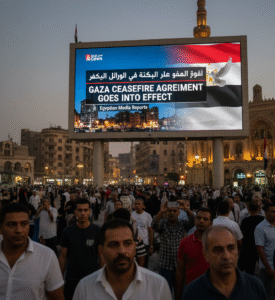
The Road Ahead: Opportunities and Scenarios
Best-Case Outcome
-
The ceasefire holds.
-
Hostage and prisoner exchanges are completed smoothly.
-
Aid delivery improves conditions in Gaza.
-
Political talks begin under international supervision.
-
A transitional authority prepares the path toward Palestinian elections and eventual statehood.
Moderate Outcome
-
Minor violations occur but are contained.
-
Some aid flows reach civilians.
-
Negotiations continue intermittently, delaying full normalization.
Worst-Case Outcome
-
Renewed clashes break out.
-
Mistrust halts prisoner releases.
-
Humanitarian aid is blocked or politicized.
-
The agreement collapses, reigniting regional instability.
The future depends on political will, effective monitoring, and sustained humanitarian support.
Rebuilding Gaza: Economic and Social Dimensions
The reconstruction phase is as crucial as the ceasefire itself.
Experts estimate that Gaza’s rebuilding could cost over $30 billion. Essential priorities include:
-
Rebuilding homes and schools.
-
Restoring water and power systems.
-
Reopening hospitals and clinics.
-
Reviving small businesses and agriculture.
International donors are expected to meet in Cairo in the coming weeks to coordinate funding pledges.
Transparency and equitable distribution of aid will be vital to avoid corruption and ensure lasting stability.
Voices from the Ground
Gazans have expressed a mix of relief and skepticism. Many families, after losing homes and loved ones, find it hard to believe that peace will last.
“I want to believe this is the end,” said one displaced teacher in Khan Younis. “But we have seen too many ceasefires fail. We just want to rebuild our lives.”
Across the border, Israelis who have campaigned for the release of hostages wept with joy as news spread of the exchange. In both societies, exhaustion from war fuels hope for an enduring calm.
Ethical, Legal, and Human Rights Considerations
Human rights groups have demanded independent investigations into war crimes and civilian casualties on both sides.
Legal experts argue that accountability must accompany reconstruction — without it, cycles of violence will repeat.
The ceasefire offers an opening for truth, justice, and eventual reconciliation if international bodies and local leaders have the courage to pursue them.
Conclusion: A Fragile Peace with Global Implications
The Gaza ceasefire agreement, confirmed by Egyptian media, represents a critical step in halting bloodshed and opening doors to dialogue.
It reflects the power of persistent diplomacy, the resilience of civilians under unimaginable hardship, and the crucial role of regional actors like Egypt in mediating peace.
Yet peace remains fragile. The coming weeks will determine whether this agreement becomes a foundation for transformation or just another pause in an endless war.
For now, the people of Gaza — weary, displaced, and grieving — cling to a flicker of hope that this ceasefire might finally be the beginning of healing.
